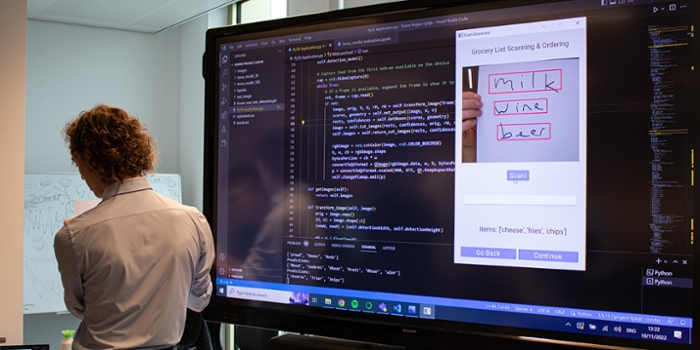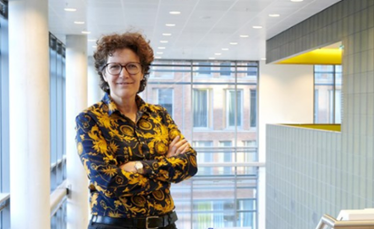System error, please restart: responsible IT in the making
Nanda Piersma publishes book and will give AUAS inaugural speech
29 Nov 2022 12:40 | Faculty of Digital Media and Creative IndustriesThe use of digital systems has boomed over the past forty years. This huge growth in the use and up-scaling of digital systems has also gone hand in hand with a need to produce rapid solutions to IT problems. "In many places we have simply used duct tape”, says Nanda Piersma, professor of Responsible IT at the Amsterdam University of Applied Sciences Amsterdam (AUAS) and researcher at the national Centre for Mathematics and Computer Science (CWI). In her book System error, please restart and inaugural speech on 6 December, Piersma describes how we nevertheless can create responsible IT systems. This can be done by helping designers make different design choices when designing digital systems.
Nanda Piersma argues in her book System error, please restart that we build IT systems one atop another, while the underlying structure of the systems was never intended for scaling at the global level and use in a different context. "If we were to do it again, we would make different choices," Piersma says.
From banks to businesses and government, we work everywhere using systems and methods still dating from the computer's past, while other, more responsible alternatives are now available. For example, computer servers are still cooled by fans, which uses a lot of energy. She asks: “If we reinvented computer servers, would we want air fans as a cooling system again, or would we seek more energy-efficient solutions?"
Duct tape
So in the current situation, IT systems are scaled up, figuratively speaking, using duct tape. This has led to careless solutions such as apps that as a rule collect data, often through third parties. Furthermore, the capitalist business model of many IT companies means there is too little room to start afresh and build responsible digital systems.

Digital integrity
Piersma argues that the founding principle of the design process should be ‘digital integrity’. "If you give blood, you have as a rule given your permission for this. But digitally, personal data are constantly being used and analysed, without your knowledge at all. These data are processed even when they are not needed." For example, when buying festival tickets, online web shops ask for your name and address in standardised input fields, even though these data are not needed.
Digital comfort
A second important principle that designers can take into account is digital comfort. Piersma: "Some apps are easy to download and convenient to use, but still cause a little voice in the back of your head to ask: Is this safe?’ What happens to my personal data? These apps invade your personal space, and that doesn't feel right."
Designers can also focus on this comfort, more deeply felt by users, rather than just ease of use. More control over data is important. "Give people control over their own IT system: Who sees my data, what can I see myself, can I block or control things? We need to bring systems closer to people. If you give these guidelines to designers, other designs will come out."
The human dimension
Another guideline is the human dimension. "We use artificial intelligence for everything these days, even for problems that have long been solved using other means. That sometimes leads to irresponsible solutions. Using cameras with image recognition algorithms to count the number of travellers on a train or in a supermarket? There are other ways of doing this. The Dutch Railways, by the way, monitors crowding by the weight of train carriages, a good solution."

Future-proof
Piersma lastly mentions future-proofing as a design principle: building sustainably and robustly for the long term. "Make sure it works and keeps working, even if the application is used on another computer system." Kate Raworth's doughnut principles fit this perfectly: use IT design choices to minimize the burden on the earth and respect the social context.
These are the four underlying principles that designers can use to design differently. A substantial difference from an ethics framework you use to check you’ve ticked all the boxes.
People will change
"We have for a long time been outspoken about what is wrong," Piersma concludes. "My team investigates how we can do things differently, to specifically nudge in the direction of being responsible. My theory is that the technology is often already there. It is people and society who will have to start implementing it. People will start to see and embrace the changes. And IT professionals are now next in line to make design choices to programme digital systems differently."

A different attitude
The pursuit of responsible IT ultimately requires a different attitude from users, Piersma argues. These have high expectations and assume that all systems work well. Users must begin to realize that ICT and cloud services are not abstract and high-tech, but have a direct impact on our physical living environment. "’The cloud’ is not a cloud in the sky, but a centre in the ground that needs to be cooled."
Data vault
Piersma does not believe that responsible IT means everything has to be redone. "Believe me, we won't be happy if later our banking app turns out not to work anymore because we started from scratch. A handy solution, for example, is a data safe, in which you store your own data and give others permission to use certain data. With a data safe, you give a shop only a safe number and the item you want to buy. You give the courier your address and to the bank you give the order to pay. That is very different from every web shop collecting all your data and passing it on to the bank and the courier."

